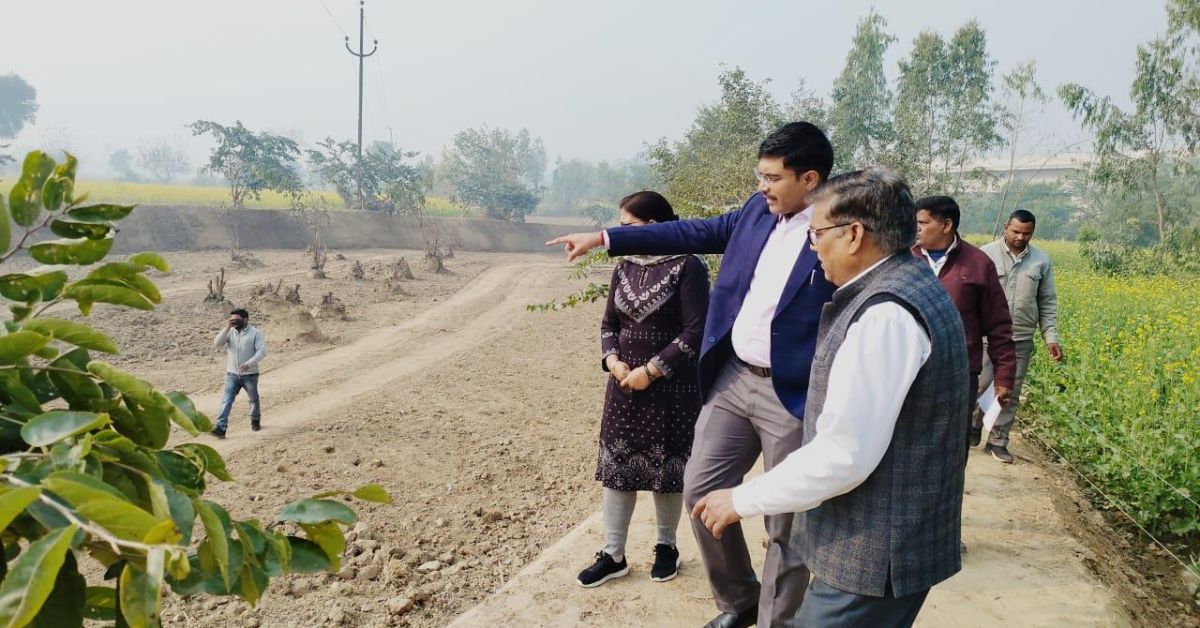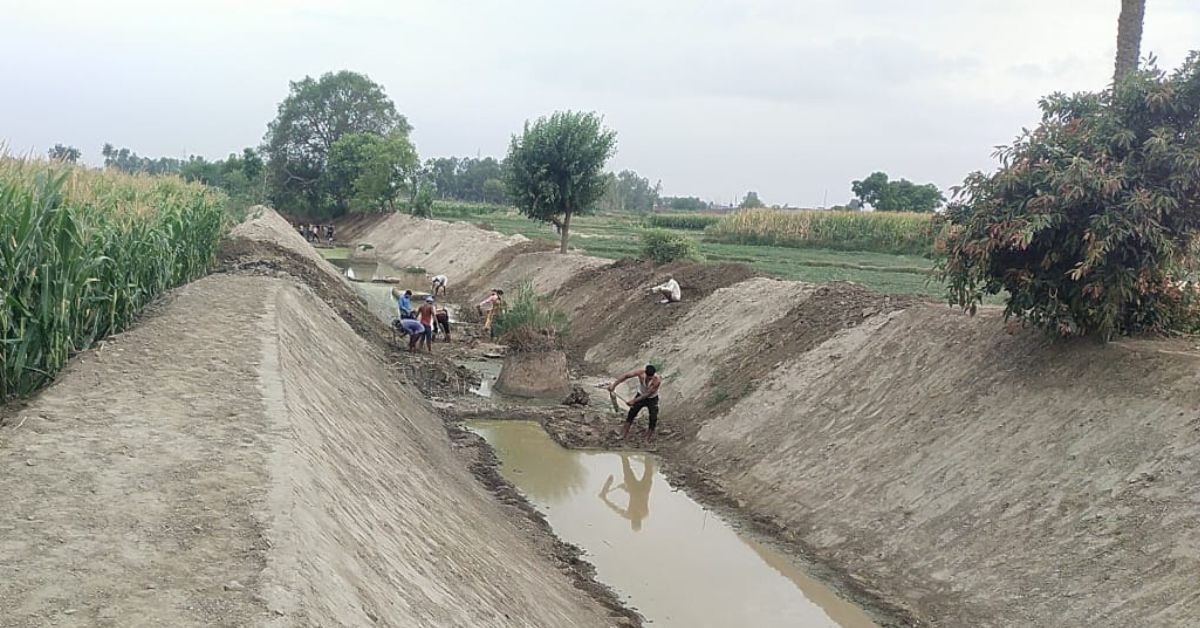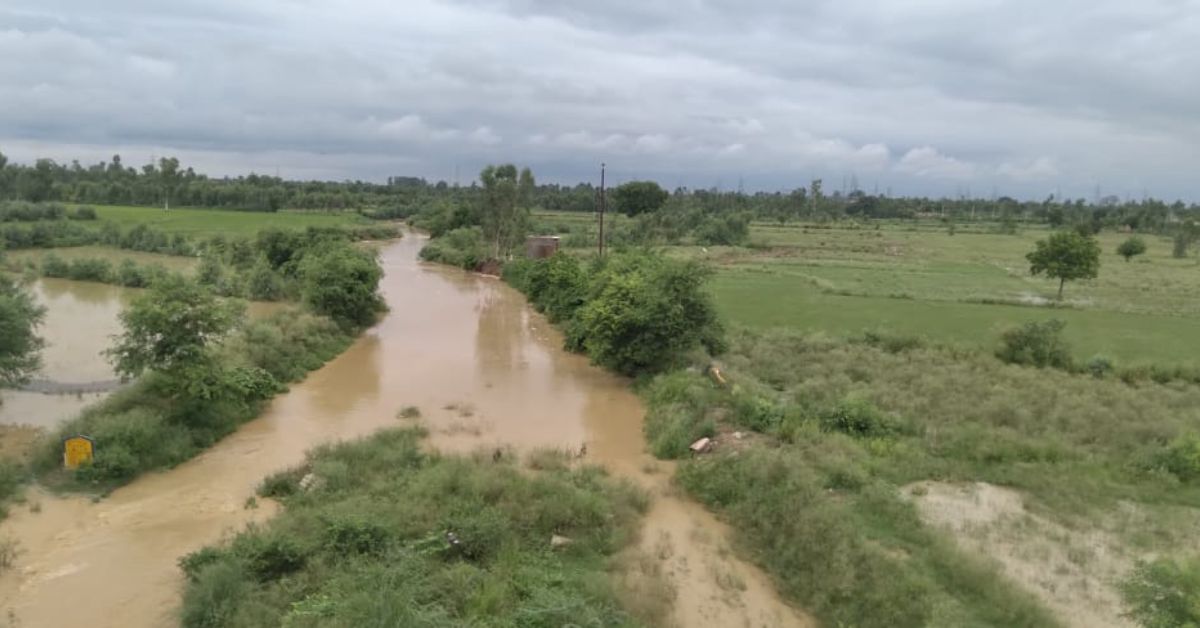Roughly 50 years ago, the Sot river – a tributary of the mighty Ganges – was a lifeline for the residents of the Sambhal district in Uttar Pradesh, with farmers depending on its water for irrigating their lush green paddy and peppermint crops.
However, the river that passes through 71 gram panchayats in five development blocks disappeared from the district due to large-scale encroachment and neglect. In 2022, when the newly-appointed district magistrate IAS Manish Bansal visited the field, he found there was hardly any water in the river.
“I saw that the river was practically non-existent. We could only see small puliya (culverts) that were once made over the river. At several points, farmers had started growing crops considering it to be vacant land. The streak of the river was not completely connected,” he says.
“At some places, the area was covered in small puddles. The river was encroached to the extent that it lost its path of natural flow downstream. Due to this, nearby areas would remain waterlogged during monsoon. Earlier, the Sot river acted as a natural drainage system for the area,” he adds.
In addition to this, the groundwater table had drastically reduced in the area as farmers became dependent on borewells, which further exacerbated the water problem in the region. “Even hand pumps, as deep as 50 feet, started becoming non-functional because of the receding water table,” says Manish.

When former district magistrate IAS Manish Bansal visited the field, he found hardly any water in the river.
. In conversation with The Better India, he shares how the district administration revived the river to its old glory.
Spearheaded by Manish, the Sambhal district conducted a survey of the length of the river. The results showed that the Sot river, which appeared to be non-existent, was actually a 110 km long stretch starting from the Amroha district in the North and flowing towards Budaun in the South.
Firstly, the administration conducted a survey to understand the natural alignment of the river. This was followed by physical demarcation of the region to learn about the length and breadth of the river. The third step was to clear the illegal encroachments.
“One of the major challenges was to remove the encroachments along the river. Using the revenue land records, we understood that there were huge encroachments on the river area which had become flat at some points. Although there was no permanent construction, people started using it to grow crops. As it was illegal usage, we sought the help of the revenue land records team to clear encroachments,” says Manish.
The fourth step was desilting of the river to remove fine silt and sediment collected in the river and restore it to its natural capacity. As part of this, the district administration roped in MGNREGA (Mahatma Gandhi National Rural Employment Guarantee Act) workers to clean and dig the riverbed afresh.
Started in December 2022, the project was completed in six months by June 2023. During the last monsoon, . The region was also free from waterlogging.

The district administration roped MGNREGA workers to clean and dig the riverbed afresh.
“Every river has a catchment area. The natural flow of water in an area will be towards the river, so runoff water from nearby areas flows in that direction. in the area but this time, this water was directed towards Sot,” Manish adds.
This development was also followed by a massive plantation drive along the river bank. As many as 10,000 bamboo saplings were planted to prevent future soil erosion.
After the project completion, it was observed that the seasonal Sot river received ample water in the monsoon and remained rejuvenated for the next two and a half months. As part of the project, several micro check dams were also built on the river to slow the runoff in the channel.
Interestingly, this work was lauded by the Prime Minister in his monthly radio programme ‘Mann Ki Baat’ in September 2023. “This proved to be very encouraging for all the officials and gram panchayats associated with the project. Inspired by this, the districts of Amroha and Budaun also undertook the project of reviving the Sot river downstream and upstream, respectively,” shares Manish.

Within six months, the district administration revived the river to its old glory.
Manish credits the success of the project to the local people, gram panchayats, MGNREGA workers, and district officials. In June 2024, he was transferred to Saharanpur district but this did not affect the success of the project.
Ram Ashish, the District Development Officer of Sambhal, tells The Better India, “We keep monitoring for encroachments and ensure that the river remains rejuvenated. Post monsoon, the soil erodes into the river. So, we are working on a plan to organise desiltation and continue the work started by Manish sir.”
He adds that while some downstream areas currently have water, they expect to see the river filled to the brim in a couple of days when it rains.
Meanwhile, IAS Manish was reached out to by residents of Saharanpur to replicate the work seeing the success of the project in Sambhal district. “Saharanpur has several seasonal rivers such as Kali and Hindon rivers. They originate from Shivaliks and pass through the district. Over the years, their area has reduced in size. We aim to work on these rivers next,” he says.
However, Manish believes that the administration can only play the role of a facilitator, but it is only when the community becomes the protector of its rivers that they can remain rejuvenated.
For Manish, the Sot river rejuvenation project during his tenure in Sambhal was extremely fulfilling. “This project was very close to my heart. Projects such as river rejuvenation take a backseat as they are not always a priority among other routine works. But if we do not rejuvenate these rivers, people will face the brunt of a water crisis. Thankfully, the State Government has also been actively focusing on the environment by and establishing Amrit Sarovar projects,” he adds.
Edited by Khushi Arora; All photos: Ram Ashish.
However, the river that passes through 71 gram panchayats in five development blocks disappeared from the district due to large-scale encroachment and neglect. In 2022, when the newly-appointed district magistrate IAS Manish Bansal visited the field, he found there was hardly any water in the river.
“I saw that the river was practically non-existent. We could only see small puliya (culverts) that were once made over the river. At several points, farmers had started growing crops considering it to be vacant land. The streak of the river was not completely connected,” he says.
“At some places, the area was covered in small puddles. The river was encroached to the extent that it lost its path of natural flow downstream. Due to this, nearby areas would remain waterlogged during monsoon. Earlier, the Sot river acted as a natural drainage system for the area,” he adds.
In addition to this, the groundwater table had drastically reduced in the area as farmers became dependent on borewells, which further exacerbated the water problem in the region. “Even hand pumps, as deep as 50 feet, started becoming non-functional because of the receding water table,” says Manish.

When former district magistrate IAS Manish Bansal visited the field, he found hardly any water in the river.
. In conversation with The Better India, he shares how the district administration revived the river to its old glory.
The masterplan behind the river rejuvenation
Spearheaded by Manish, the Sambhal district conducted a survey of the length of the river. The results showed that the Sot river, which appeared to be non-existent, was actually a 110 km long stretch starting from the Amroha district in the North and flowing towards Budaun in the South.
Firstly, the administration conducted a survey to understand the natural alignment of the river. This was followed by physical demarcation of the region to learn about the length and breadth of the river. The third step was to clear the illegal encroachments.
“One of the major challenges was to remove the encroachments along the river. Using the revenue land records, we understood that there were huge encroachments on the river area which had become flat at some points. Although there was no permanent construction, people started using it to grow crops. As it was illegal usage, we sought the help of the revenue land records team to clear encroachments,” says Manish.
The fourth step was desilting of the river to remove fine silt and sediment collected in the river and restore it to its natural capacity. As part of this, the district administration roped in MGNREGA (Mahatma Gandhi National Rural Employment Guarantee Act) workers to clean and dig the riverbed afresh.
Started in December 2022, the project was completed in six months by June 2023. During the last monsoon, . The region was also free from waterlogging.

The district administration roped MGNREGA workers to clean and dig the riverbed afresh.
“Every river has a catchment area. The natural flow of water in an area will be towards the river, so runoff water from nearby areas flows in that direction. in the area but this time, this water was directed towards Sot,” Manish adds.
This development was also followed by a massive plantation drive along the river bank. As many as 10,000 bamboo saplings were planted to prevent future soil erosion.
Maintaining the river’s restored glory
After the project completion, it was observed that the seasonal Sot river received ample water in the monsoon and remained rejuvenated for the next two and a half months. As part of the project, several micro check dams were also built on the river to slow the runoff in the channel.
Interestingly, this work was lauded by the Prime Minister in his monthly radio programme ‘Mann Ki Baat’ in September 2023. “This proved to be very encouraging for all the officials and gram panchayats associated with the project. Inspired by this, the districts of Amroha and Budaun also undertook the project of reviving the Sot river downstream and upstream, respectively,” shares Manish.

Within six months, the district administration revived the river to its old glory.
Manish credits the success of the project to the local people, gram panchayats, MGNREGA workers, and district officials. In June 2024, he was transferred to Saharanpur district but this did not affect the success of the project.
Ram Ashish, the District Development Officer of Sambhal, tells The Better India, “We keep monitoring for encroachments and ensure that the river remains rejuvenated. Post monsoon, the soil erodes into the river. So, we are working on a plan to organise desiltation and continue the work started by Manish sir.”
He adds that while some downstream areas currently have water, they expect to see the river filled to the brim in a couple of days when it rains.
Meanwhile, IAS Manish was reached out to by residents of Saharanpur to replicate the work seeing the success of the project in Sambhal district. “Saharanpur has several seasonal rivers such as Kali and Hindon rivers. They originate from Shivaliks and pass through the district. Over the years, their area has reduced in size. We aim to work on these rivers next,” he says.
However, Manish believes that the administration can only play the role of a facilitator, but it is only when the community becomes the protector of its rivers that they can remain rejuvenated.
For Manish, the Sot river rejuvenation project during his tenure in Sambhal was extremely fulfilling. “This project was very close to my heart. Projects such as river rejuvenation take a backseat as they are not always a priority among other routine works. But if we do not rejuvenate these rivers, people will face the brunt of a water crisis. Thankfully, the State Government has also been actively focusing on the environment by and establishing Amrit Sarovar projects,” he adds.
Edited by Khushi Arora; All photos: Ram Ashish.
